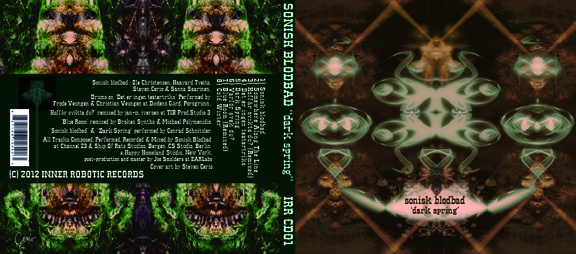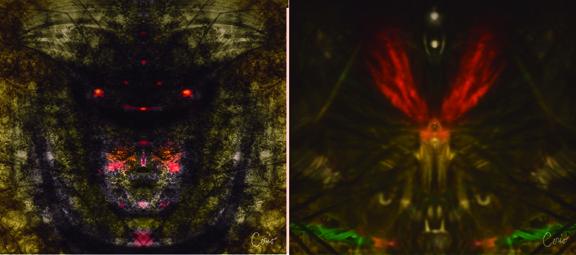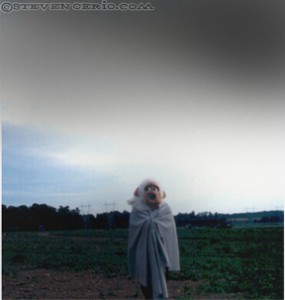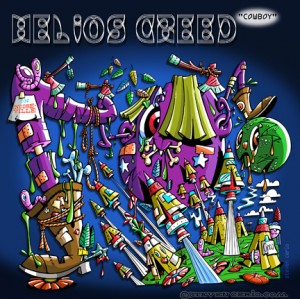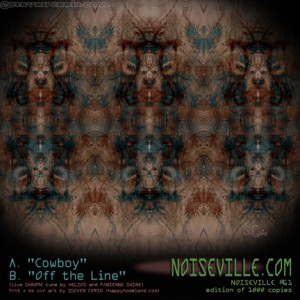“Atlantic Drone”
Interview with Steven Cerio
What is the idea behind Atlantic Drone?
Seems I’ve always wanted to do a prog-improv-ambient hybrid. I wanted to play with my friends in all different parts of the world and found a way. I knew that improvisation would need to be an important part of our process but we had to approach it in my own way, with written bookends and various approaches that remove the “wankiness” and din that is associated justly with free form. I decided to tape everything we did: catch their “births” on tape. Then I listen back and save the prettiest butterflies.
How did you find people to collaborate with that understood your intentions?
I have had a difficult time finding musicians in our area that know music theory beyond classic rock and pop traditionalism. They either become threatened by the challenge of my prescribed approach or they revert back to more traditional approaches. My solution was to call friends of mine from New York and Europe that I know from my touring days and have them contribute. With home studios being so common nowadays we can record with people all over the planet. Lore Barges contributed from Paris, she has an amazingly twee band called Dragibus. Michael “DustDevil” Duane who was the brain behind The DustDevils recorded his overdubs in England. Sal Canzonieri (The Thing and Electric Frankenstein), Dave Rick (Yo La Tengo, King Missile, Bongwater) and Jim Gibson from Toothfairy met me out in Jersey to lay their tracks down.
Working with seasoned experimentalists yields far better results and I don’t have to waste time babysitting. We pretend we’re performing songs we’ve already written and that seems to keep our mind on composition. We play our thoughts as best as we can and avoid any habitual approaches. I haven’t, won’t, will not and can’t play with stereotypical rock musicians anymore. I had enough of that in my Matador Records days. They can all keep their leather pants, scary skull tattoos and teen angst. Pretty is much harder to come by.
I just want to feel “fine”, “good” and “happy” occasionally and find a way to trap it for documentation and study. Who knows, maybe I can get it to multiply in the correct environment…… I want to make a benevolent music.
What kind of direction do you give your contributors when you create a song?
Some tracks require teaching the composition while I prefer to get most tracks on tape while the musician is hearing it for the first time… this insures freshness. They are there in the original improvisation or as close as can be arranged.
I think it’s very important and very thrilling to get the genesis of a track on tape. You’re taping its birth. We don’t play jazz but the same thoughts and freedoms are up inside of it all.
Is there any specific process to your writing that helps you get to where you want to be in the song?
Formula cannot get me there since I’ve never figured out “why” my stuff works…and I hope I never do. It isn’t a factual exercise. Our music has such a large amount of improvisation that our process demands those instinctual reactions for each piece to be successful. I’m very critical. I throw out almost ninety percent of everything I record. I can afford that luxury since I have my own studio. We have no expectations when we begin a session and I have none when I begin the mixing. Each has to be treated with its own set of rules that reveal themselves as the mixing and overdub process goes on.
What kind of music do you find the most stimulating or inspirational?
The music that influences me most are compositions and textures that confuse me with their logic. I rarely perceive those qualities in any traditional approaches. When musicians using traditional forms occasionally vary their approach from that learned norm it is usually met with hostility [even] when it is what the forms demand in order to move forward. If they don’t, the listener gets told the same thing over and over again until even small children get bored with the message. All the music I love can be traced back to Coltrane; he laid the tracks down and built the roads. I read some old reviews of “A Love Supreme” when it was released and was shocked! The traditionalists that have always believed that they own the intellectual right to jazz called his work “anti- jazz” and said he was killing it but as it turned out Coltrane, Ornette and Cecil were giving it a new life.
All of the traditional forms are symbiotic with the new interpretations. They define each other. After a form evolves out of its box and the top closes it gets a nice place in history which benefits both forms equally. Would anyone dare to compare their own work or anyone else’s to Hank Williams, The Carter Family, Led Zeppelin or the Beatles? Never, they exist in an envied, quaint mystical place in the past whether they are still working or deceased.
What sort of state of mind/feeling would you like your listeners to get from listening to this record? How does it make YOU feel?
I compare music to the temperament of a person’s speech. Atlantic Drone whispers in your ear but you hear only every other word. You catch a phrase or two, get a glimpse of the landscape, then build the story for yourself. I’d like them to go somewhere that they’ve never been and feel blissed out and energized and hypnotized by their own phenomena when it gets stirred up. Of course you can never account for where someone goes, like in any art form there is no exacting communication. Every note, image or sensation creates a different response in every person that experiences it. I can only hope that that I can cause a new connection in a brain somewhere: maybe two memories that have never met get stuck together with some synaptic super glue.
I can only know what “I” like and I can feel when something is “my” brand of psychedelic. I feel a bit confused, pleasantly lost, excited and very awake. This release makes me feel a sensation like moving forward on a bicycle without the bicycle. Everyone has their own triggers just like in sex. A series of fetishes: a series of notes, a guitar effect, a nice pattern, a certain word. You can’t account anyone else’s triggers but I know mine and I hope they are resonant to someone else, or I just might be drawing and recording for myself.
Sometimes I’m firing really well, not even an exhaled cloud of smoke goes up without me finding faces in it. Other days I’m in this irritating reality of reality television, banks, diseases, pick up trucks and beer drunks.
How does Atlantic Drone compare to past psychedelic bands?
I didn’t set out to comment or meditate on any past tradition but I like to think we may have been inspired by some of the same meditative spirits or psychedelic intentions as Pharoah Sanders, early Soft Machine, Can, Faust, or Captain Beefheart.
Atlantic Drone isn’t retro-fueled, I don’t do rock or blues beats and we are light years from being a jam band so “neo” psychedelic doesn’t work as a pigeonhole for us. “Post Psychedelic” is more appropriate since we create psychedelic music without commenting on the Sixties with our approach. What we do is between soundscape and song, between improvisation and structure…so what are we? I’m not sure myself and I’m proud of that. I’m not even sure where on the timeline we’re talking to you from. Do you? A friend of mine called it “improg” …I like that.
As a drummer and an artist, how important is rhythm in writing improvisational music?
I see my music as time decorated with occurrence. I see popular radio music as stories wallpapered with time. It’s very easy to disturb a person’s perception of music if they were raised on Pop. They were taught to think in what Captain Beefheart calls “the Momma heartbeat,” which is throbs of twos, fours, eights and twelves. If you give them seventeen beats per measure it will irritate them. Most people have become rhythmically challenged by any new approach after ingesting giant doses of dance and rock n roll. They demand the pleasure of easy tapping. If someone sat in a room without musical accompaniment and tapped an evenly spaced, even tempo, repetitive beat for the length of the average pop song you would think they had gone insane. If they perform that action along with the newest jingle by Britney Spears or any other marginally talented group of business-minded cut out dolls, how is that any less disturbing? Repetitive action as a substitute for ideas is moronic. Loops sound like the end of creation to me. I find them sad. They sound like the death of ideas. I grew up admiring musicianship, not studio trickery and machines.
What about harmony in a composition?
I like frequencies to compete with each other; it lessens tension though you would imagine it would do exactly the opposite. I like the focus to fade in and out. I like guitar sounds that dip in and out of the rhythm section. I wash the grit out of them and tweak them in the mixes until they fit the organism.
My approach to harmony is to use differing approaches layered on each other until a theme or passage appears from their placement. The listener can choose which line to follow. That makes the pieces dense enough for multiple listening while still retaining a bit of conventional melody.
What types of effects/sounds/instruments did you most enjoy using on this record and why?
I’m in love with using Jeff Hick’s Theremin set up. He uses multiple synths and Theremins simultaneously. Sometimes Bryan Kieser runs his horn through the set up. I’ve run my trap kit through it as well and he improvises the drum mix. Something about the way Jeff handles the rig gives the music a great sense of depth and a sonic Doppler Effect.
I generally dislike cymbal crashes. I prefer the sound of a well tuned drum. I tune mine to the specific piece we’re playing. The largest crash I use is a ten inch Wuhan since the large cymbals tend to hog frequencies. I’ve never heard a crash so beautiful it deserves to outrank a melody. They create a shimmering high pitch which isn’t really much of a miracle.
I pick instruments for texture. We used synth, drum kit, percussion, contrabass, violin, cello, guitar, bass, organ, xylophone, sitar, harmonica, Theremin, voice and six varieties of brass on this latest disc.
Is it a challenge to use so many different instruments without the mix turning into mud?
The challenge with using all of these instruments is too keep some air and space in the performance. The key in the initial recording is to avoid habitual approaches by relaxing, reacting in the moment and avoiding wanky bursts of practiced virtuosity. I spend months on each tune getting all of the instruments to come to agreements with each other. I weave them in and out and under and over each other like a school of fish. Nothing is mapped out so each instrument has to earn its position organically. It’s Darwinism in action.
I noticed that vocal lyrics are minimal on these songs, what effect does that have on your songs?
Pop music uses musicians solely as soundtracks to sit the lyrics on. When a verse comes on in a radio tune you must have noticed that all musicians minimize the detail and volume of their approach. Elvis, Patsy Cline, and Brenda Lee could have played with almost anyone and the discs would have sold.
There has to be a struggle for importance, volume and clarity between every instrument and voice for any recording to be vital. Though I often write many pages of lyrics for most songs only a small fraction make it through the editing process. I use the lyrics to introduce you to the landscape that is the instrumental. The landscape comes first, then the signposts.
Being that you are also a visual artist as well as a musician, how does that affect the final outcome of your songs?
That comes out in the mixing of the songs to create their final shape. I approach the mixing board with the same intentions that I approach my drawing table with. They are both meant to create the same effect. I approach them both with the same exhaustive work ethic and intentions and each exhilarates me in the same way
Both my art and mixing evolve from a series of spontaneous ideas. I mold the sounds in the mixes to be creamy, light, and round. And like in my graphic work I took all of the sharp edges off of everything. As each line and note is layered with newly formed ideas, the composition becomes increasingly complex.
The original sounds that were recorded are not “guitar” or “drums” any longer when mixing, instead the sounds they made are molded into new shapes.
One of my visual and aural triggers is the cross pollination of emotions and intents -which shouldn’t be confused with irony or juxtaposition. If I have laid down a sneaky sounding track I might ask a guitarist to play something that sounds drowsy or happy to them or I might ask Bryan Kieser to play his perception of Ravi Shankar’s sitar on his alto sax. What you can get is indefinable intentions or emotions that in themselves are very psychedelic to me.
To find these moments, I’ve thrown away dozens of tracks. I demand that each track has to maintain its own organic life after it’s on tape. Sadly, many wind up in the recycle bin on my pc. If it doesn’t take me anywhere I move on. Luckily, we have a studio that Mike Paduana built for us so that we can do twenty takes of an idea or do extended improvisations and judge them at a later date. When you are performing and getting up inside of a piece, you may think its genius, only to find it was lacking the next day. It’s a luxury being able to step back and pick through hours of tracks; exhausting but luxurious. The editing process is very important in my music. Since I’m not worrying about studio bills I’ve been able to use that energy and time to listen very critically to each take.
You call Atlantic Drone a “psychedelic” band; do the effects of psychedelic drugs come to play in your music?
I think people have forgotten that Prog is a psychedelic music. You could never get an early Genesis, Pink Floyd, Soft Machine, King Crimson or Yes without some enlightened hallucinations. You can’t listen to their music without getting lit up. That is the exact definition of psychedelic music in my opinion.
I think there are three different approaches to the use of drugs for enhancing the creative process. The first group uses while recording and performing, believing their technique and ideas are enhanced by the substance. The second is the individual or group who has not had any psychedelic revelations or experiences but mimics the sounds, ideas and traditions of psychedelic musics they’ve been exposed to. The third group takes notes when under the influence, documenting the effects and their cravings so their creations will trigger similar reactions from their listeners. This is the approach that Atlantic Drone prescribes to.
Psychedelic drugs can be a learning tool. They can give you a shortcut to a fleeting well being, power or vision. Though they are beautiful illusions, making any aesthetic decisions under their influence has never seemed smart to me. I like to be here when I make decisions. Pot smokers seem to think they are at their best when stoned. They must think that the THC releases their genius from some mystical hippie gland at some undisclosed location on their body. I’ve never played with a musician who did their best work high.
If you made a visual representation of your entire record on CIRCADIA or of individual songs on the record, what would they be of?
The name “Atlantic Drone” come from a hallucination brought on by exhaustion that I had while living in Brooklyn. I had been up for a full two days trying to finish three separate projects. I was repackaging Renaldo and the Loaf’s “Arabic Yodeling” and the ‘Elbow is Taboo” for cd and a portrait of Sun Ra for the Village Voice. I remember those details because those originals are still blood stained from when I cut myself with an Exacto blade I was using and had to cab it to St. Vincent’s to get stitches. A few minutes before the cut I closed my eyes and imagined that my head became a bumble bee and it was flying down the East River and following it out to sea and then heading across the Atlantic. By the time I was half way across I realized that my new body was covered in sores and wrapped in bandages and there was nowhere to land. I still remember it in fine detail. I remember the smell of the air, my short fur and the realization that I didn’t have legs. Even if I did find a landing strip or flower I was gonna have trouble. Before this experience I had been deeply interested in bees but at that point I had re-imprinted on them like a baby gosling does to its new mother goose. My friend Cindy, who I’ve known since I was three, reminded me of our bee collecting as preschoolers which must have some part in it.
I have been working on adapting the stories hinted at on the disc for a comic for the last year. If I had the room I would have illustrated every track. Maybe CIRCADIA will let me do that for the next disc.
The lyrics in “over fed” are a play on the final lines of “Kubla Kahn” by Samuel Taylor Coleridge where the author claims to have discovered the secrets of attaining immortality. My original unedited lyric was “for they have over fed on honeydew and sunk the milk of paradise.” I would represent this track with the last living man and woman posing as an Adam and Eve at the end of a reverse evolution of human life, which is a very comforting and perfect solution to all of this.
“my kingdom for a confection” is another chapter in my ongoing obsession with using candy as a symbol for joy. Despite how much I despise and hate symbolism in any form- don’t symbolize it, give it to us-, I can’t help myself in this case.
Not to be taken in sarcasm the lyrics imagine a world, a world without viciousness where happiness is constant and equally distributed. It questions, like most themes on the disc, why is pleasure so fleeting no matter what is done to preserve it? Worry and misery last a good long unwelcome time without any encouragement. I would represent this track with a drawing of the vivified sugar cube sitting safely and bone dry on a mountaintop with sunbeams shooting out of it
“brave commander Farla approaches the sun” was named after a dream I had where I was floating in space and Farla, my cat, came up to visit me in her rocket. I see her thru the window: I knew she had tea for me. I can see her mouth moving but I can’t hear a word thru the thick glass. I think she stopped by for tea on her way to the sun. The song is a soundtrack that plays on her way to the sun. You can hear recordings of her voice throughout the track and various other places on the album …I love being able to say ‘album’ again, its been a long time.
“paleface charms the sugarbowl” is the second track I’ve done about a green plastic tea cup I found in Arizona, miles from any roads. It was half buried in the dirt near an abandoned adobe hut. I’ve dated the cup to the early sixties. The lyrics are narrated by a woman watching a male character I imagine holding the dry cup wishing he had some sugar, tea and hot water. A photo of the cup would do it for me on this track.
“be it wonderful” is supposed to be a pretty summer day song….thick and flowery. I imagine a little girl sitting on a blanket on a well manicured backyard somewhere singing it. Laure Barges from Dragibus sent the vocal to me on cassette years ago. I have no ideas what the lyrics are about…cant understand French but I always think I hear her say ‘be it wonderful” at the end, which is nice to hear.
I used sections of my friend Tom Scharff’s tapes of his talks on meteors and meteorites for “comets and Clovis” I cherry picked the lines where science and fact faded into guessing and confusion about the subject…the frontier. When I hear this track I like to imagine a primitive Clovis Man laying on his back on a grassy field at night, resting after a long day of doing caveman stuff, when a comet shoots by. I still get excited when I notice one. What would an early version of man think of that?
“the sky behind her” is a song for Farla, my mom and sister who all passed away recently. I had my friend Jason read it. The lyrics are about a narrative I wrote while under the influence of some opiate-which I was using to self medicate the depression with. In the story I was walking with a green pig- a negative interpretation of those fictional sky gods that people believe are watching out for their best interests. I described how beautiful the three of them were to the pig but he wasn’t impressed…more concerned with impressing me with his power to dispense with life. I was far from impressed and quickly found myself kicking it to death-something I would never do to a pig.
On a more pleasant note: “only orange thru the eyelids (for Farla)” reminds me of sitting in the sun with your eyes closed and that beautiful color you can see if you face the sun directly. I have fond memories of sitting in the yard near the window to my studio while Farla watched me thru the screen. I would draw her as a Mayan Leopard goddess, resting on a windowsill with an overflowing bowl of Kookamunga cat treats next to her. No matter how many she eats, the bowl stays full. A cornucopia of catnip enriched snacks!!!
The images that were used for the album art are different variations of paradise that the vivified sugar cube offers Farla and the vicious universe hoping one of them will save it from melting into the hot tea.
thanks!

